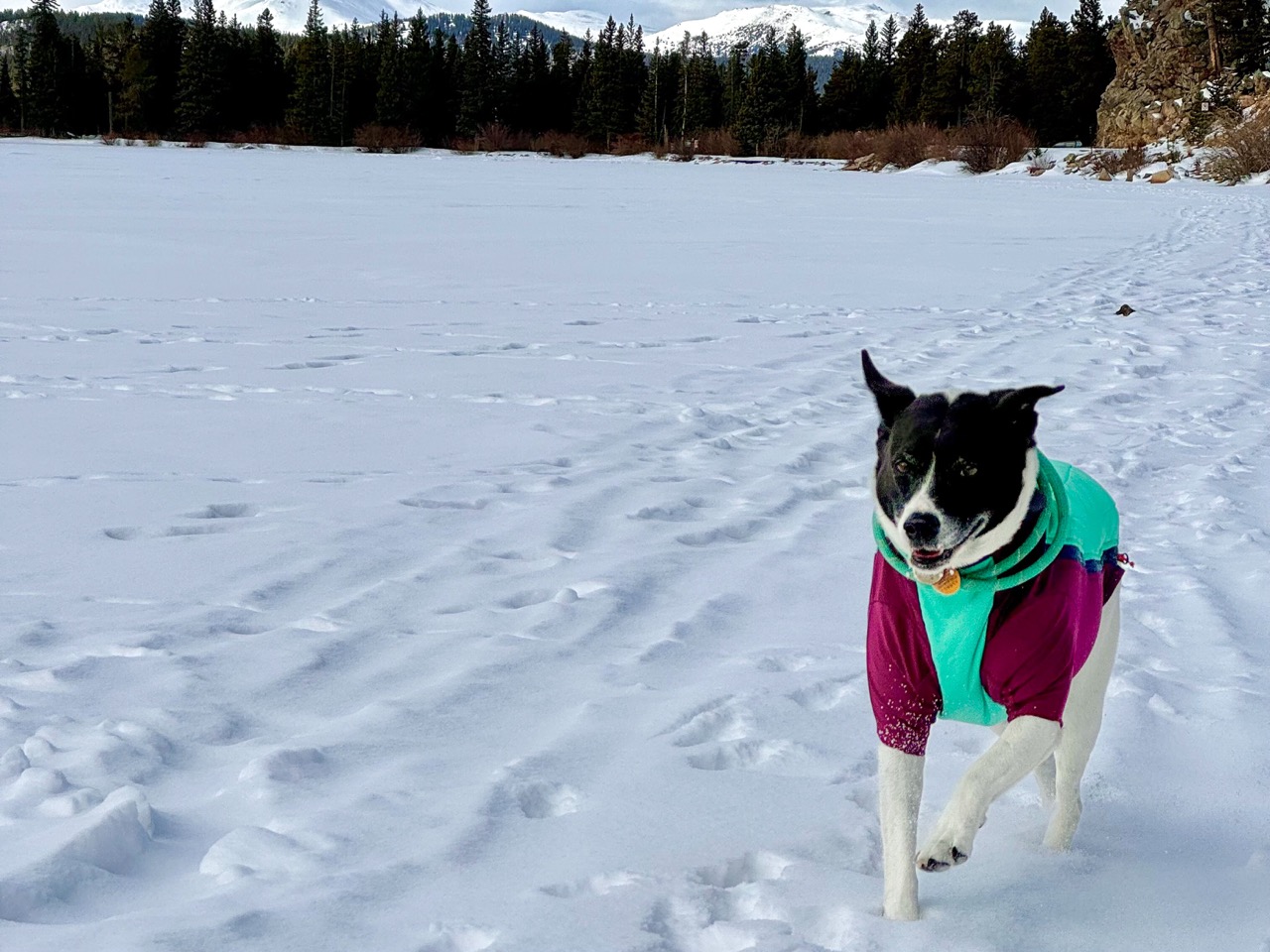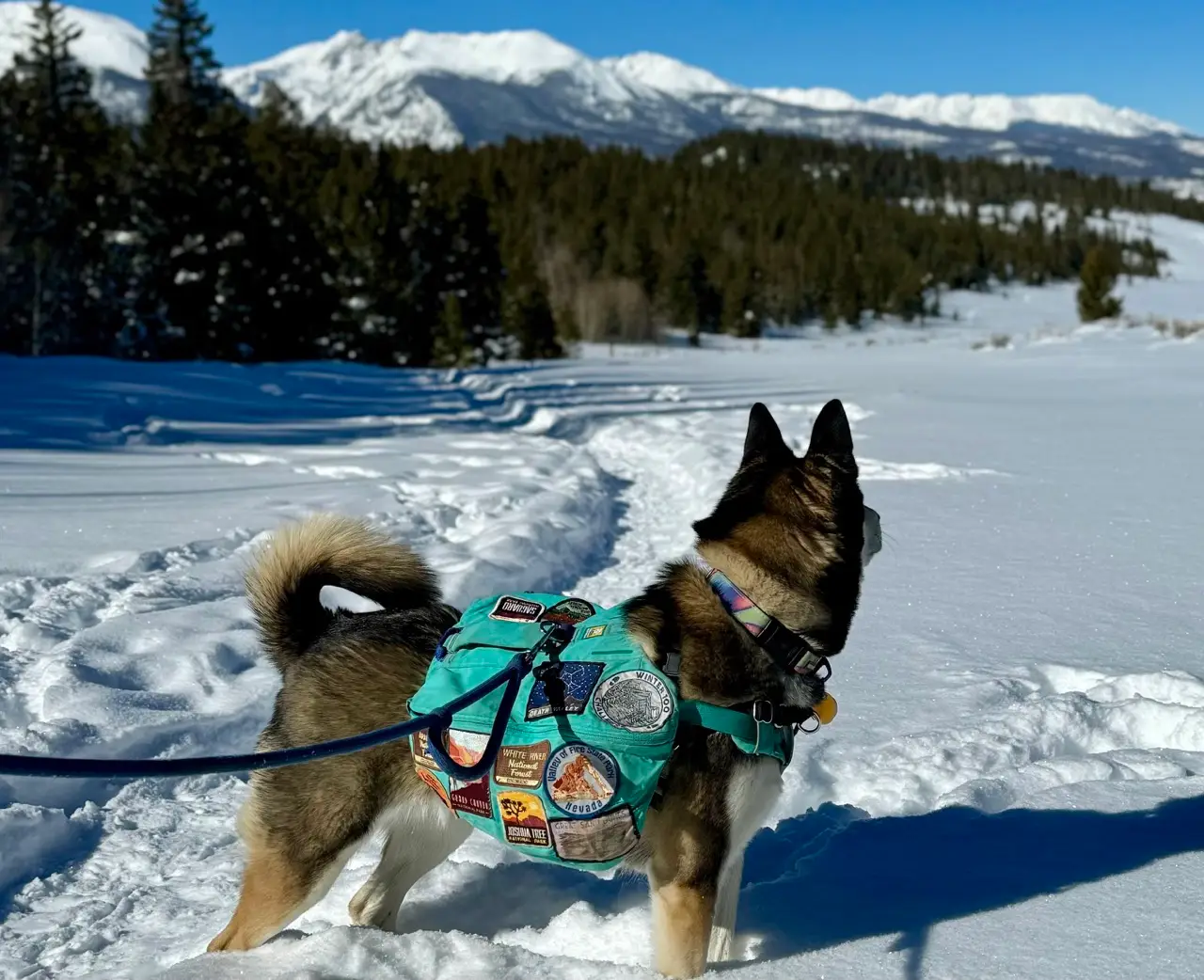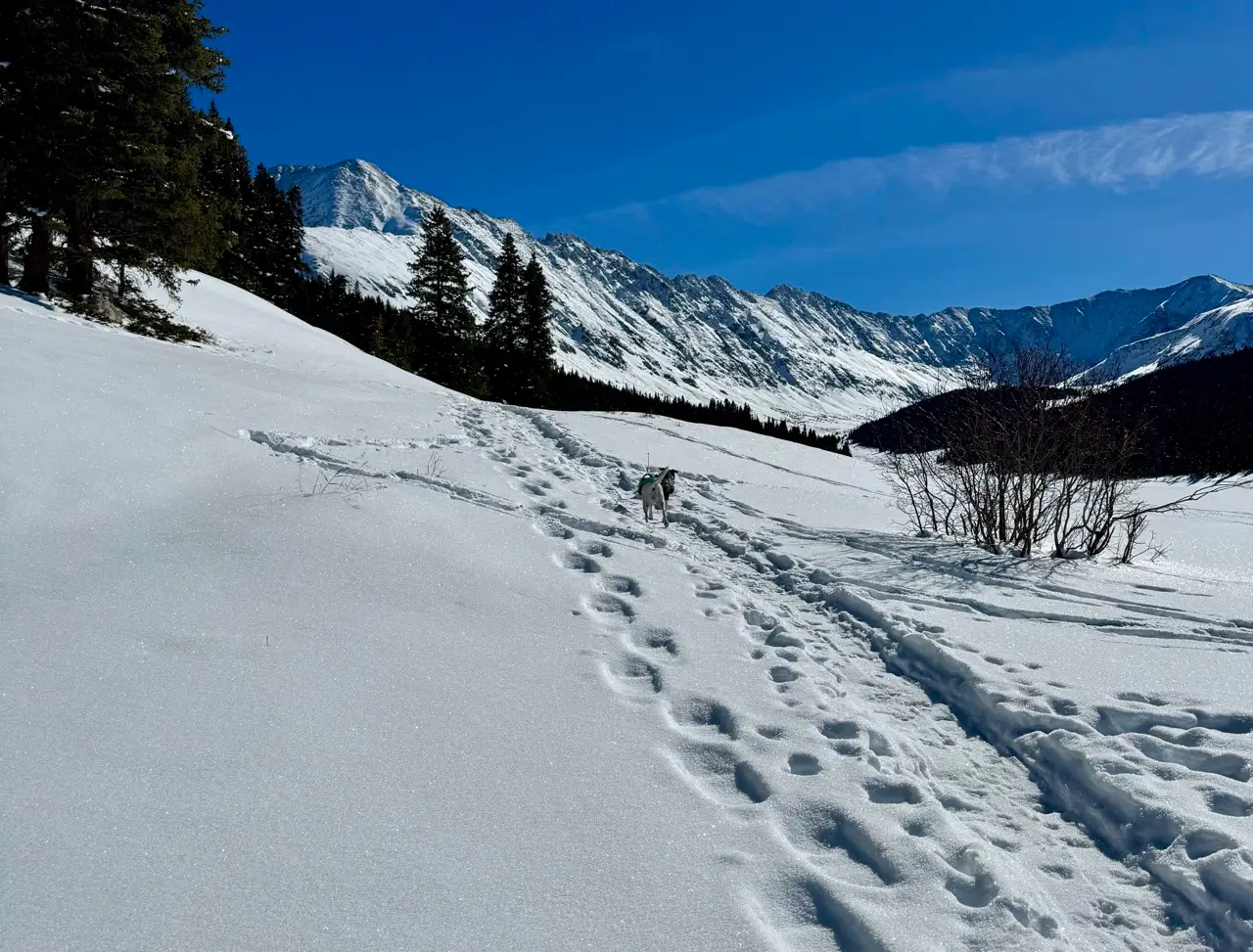Snowshoeing with your dog: Tips and trails near Denver, Colorado
Whether you’re brand new to snowshoeing, or you’ve done it before, you’ll find something useful here. In this post, you’ll find everything you need to know about gear (for both you and your dog), how to snowshoe, as well as tons of trails to try for all different difficulty levels and types of terrain – ALL dog-friendly!
This site contains affiliate links, which means when you click, we may receive a small commission from your purchase at no additional cost to you. This helps us run this page and offer great content free of charge, and we only recommend products that we use and love. We appreciate you!
Have you wanted to try snowshoeing but not known where to start? Felt intimidated? Felt confused by the gear? Look no further, because we’re here to share everything you need to know in order to snowshoe with your dog.
Everything to love about snowshoeing
Snowshoeing is fun because it turns a snowy day into an adventure, giving you the freedom to explore places that might otherwise be inaccessible. It’s easy to learn, making it enjoyable for all ages and fitness levels, whether you’re trekking through peaceful forests, climbing snowy hills, or spotting wildlife tracks in the untouched snow.

In essence, snowshoeing is a form of hiking with a little bit of gear. Snowshoes provide a wide base that allows you to walk over any snowy landscape without slipping or sinking your feet into deep snow. Some trails stay packed down enough to hike in the winter with microspikes over your boots. But snowshoes truly allow you to hike anywhere, no matter the type of snow conditions. So learning to snowshoe opens up the winter hiking possibilities to an endless array of adventures for you and your dog.
The simplicity of the activity, paired with the joy of being outdoors in a sparkling winter landscape, brings a sense of accomplishment and playfulness to every step. Plus, it’s a great way to share laughs and create memories with friends, family, and most importantly, your dog!
When should I snowshoe? When should I hike with microspikes?
Winter hiking and snowshoeing both allow people to explore snowy landscapes, but they differ in technique and equipment. Winter hiking is simply hiking on snow-covered trails, often using regular hiking boots or boots with added traction devices, like microspikes, to prevent slipping. It typically works best on packed or shallow snow.
Snowshoeing, on the other hand, uses specialized snowshoes that distribute weight more widely, allowing hikers to walk on deep, powdery snow without sinking in. While winter hiking is best for well-traveled or compacted paths, snowshoeing opens up more freedom to explore deeper, untouched snow where regular hiking would be difficult.
As the winter months plug along, the likelihood of needing snowshoes in the mountains increases. Snowpack increases, melting decreases, and the likelihood of trails staying packed down becomes less reliable.
A good rule of thumb to remember is that you can snowshoe any trail with snow on it, while you can’t necessarily hike any trail with snow on it, because many trails get to certain points where traction devices are not adequate and you begin to sink into the snow.
Alltrails reviews are an incredible tool to use to figure out if people have been hiking a trail, and the likelihood that the snow will be packed down. However, when I first started winter hiking, I would always bring snowshoes in addition to my regular hiking gear, so I would have the option to switch gears if the terrain didn’t turn out the way I expected.
Snowshoeing gear
You can either rent or buy gear, and we recommend renting your first time out, just to make sure that you like snowshoeing enough to continue. The biggest thing you need to know no matter if you’re renting or buying, is your accurate height and weight. This will determine the size snowshoes you get. If your snowshoes are too small for your height and weight, you will sink into the snow instead of gliding on top. And if you get snowshoes that are too large, they will be hard to walk in. So as long as you know your height and weight, you’re ready to go!
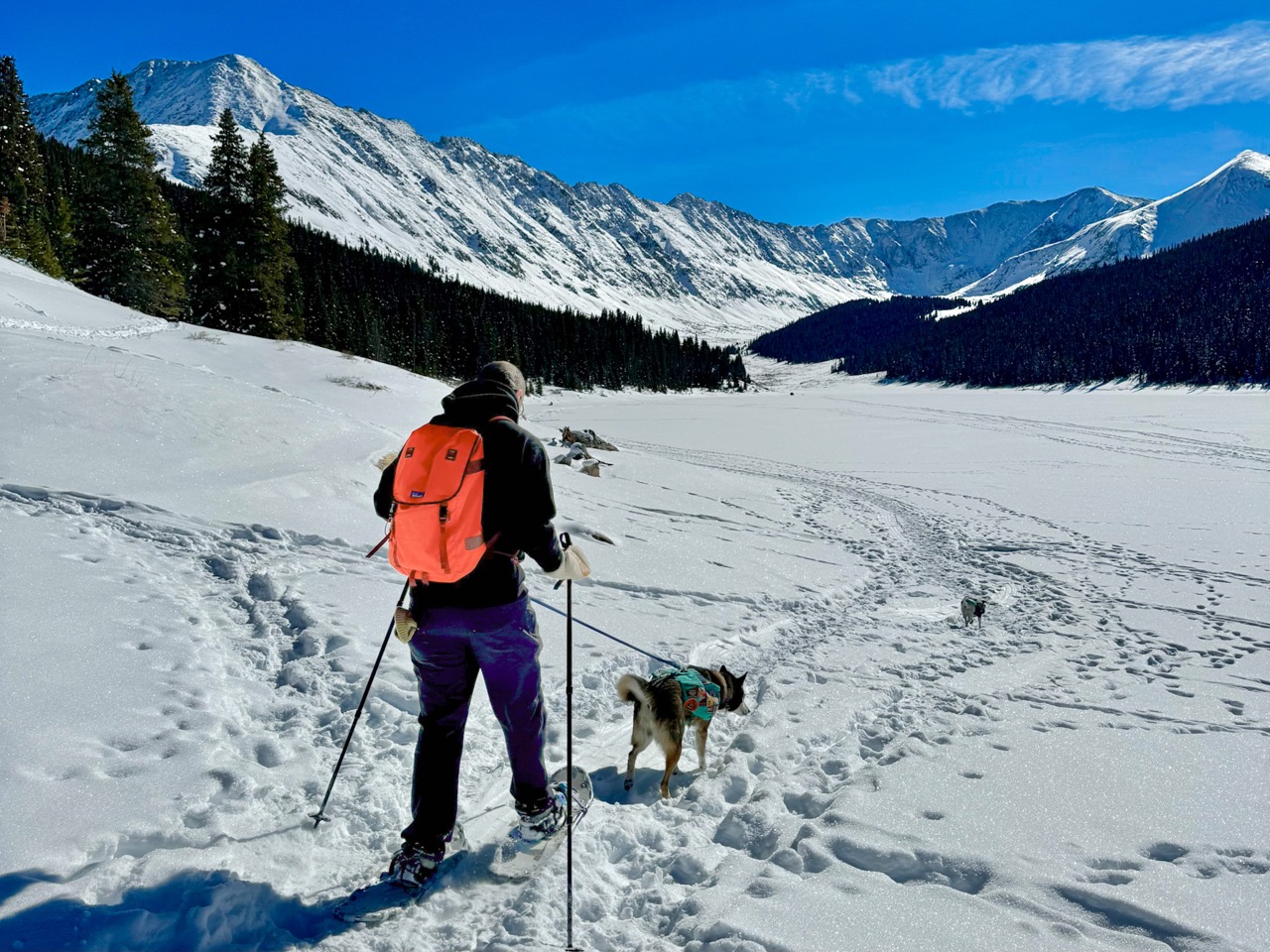
Renting
Luckily there’s not a ton of technical considerations for snowshoes, so if you’re a recreational snowshoer, or just starting out, rental gear will work just fine. To find rental locations, look for nordic centers, shops that rent ski gear, or sporting goods stores. Here are a few of our favorite shops to rent from in a variety of locations. (I’m listing local mom & pop type stores here because I like to support them, but you can also google snowshoe rentals and find a variety of places.)
- Crystal Ski Shop, Boulder
- Mountainside Gear Rental, Golden
- Larson’s Ski & Sport, Wheat Ridge
- Colorado Sports Rent, Westminster
- Columbine Ski & Sport, Dillon
Buying
When you decide you want to snowshoe regularly in the winter, it’s definitely worth purchasing gear. Owning gear will save you money in rentals down the road, and save you the hassle of picking up & dropping off gear every time you head out. Unlike ski gear, however, there’s not a ton of technical considerations or huge brand differences. Gear-buying can be intimidating, but my biggest recommendation is just to not overthink it, buy correctly sized gear, and you’ll be good! I’m recommending my favorite snowshoes, but honestly, my biggest recommendation is to aim to buy after April when brands go on sale, and just get a good deal.
- Our favorite snowshoes: Atlas Montane Snowshoes
- Our favorite Trekking Poles: Trailmade Trekking Poles
Additional (human) gear
In addition to your actual snowshoes, we recommend tailoring your outdoor adventure clothing to allow for shedding or adding layers. Since Snowshoeing is active, your body will stay warm, but you don’t want to let yourself get sweaty under your clothing. The following list is how I dress, and I always bring a backpack so I have a place to keep layers I shed.
- Baselayer bottom
- Baselayer top
- Waterproof pants
- Puffy jacket layer (for warmth)
- Shell layer (for wind, rain, & snow protection)
- Hiking boots
- Wool socks
- Hat
- Waterproof Gloves
All of our favorite winter gear can be found in this Rockporch locker below
Gear considerations for your dog
Your dog’s enjoyment of snowshoeing will depend on their readiness as well, and there are a few things to take into consideration.
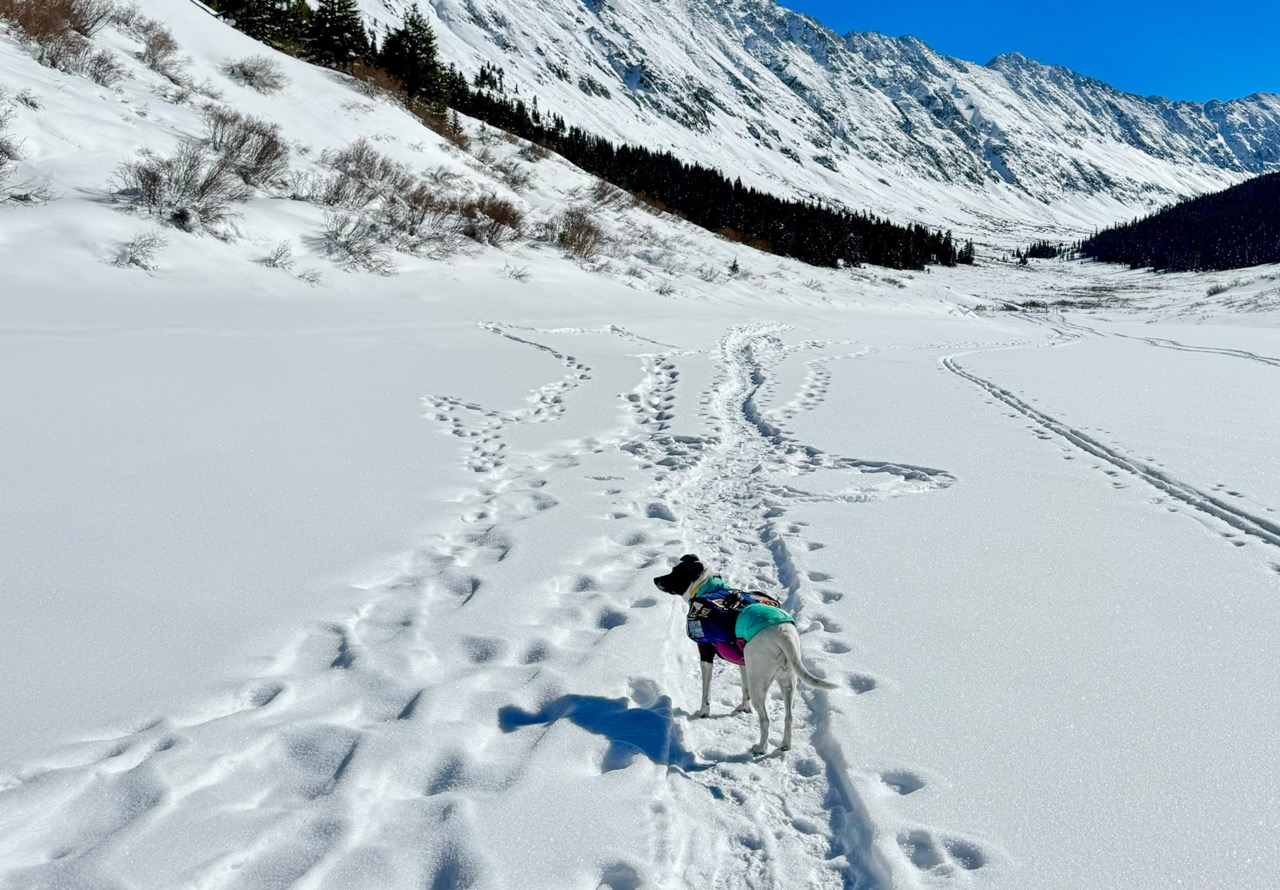
Paw protection
First and foremost is to protect their paws. We use paw wax to protect from the cold on icy surfaces. But if they will be able to run through deep snow, consider boots that will protect their paw pads from getting cut or scraped by hidden objects like sticks & rocks.
- Paw wax – Our favorite is Musher’s Secret
- Boots – Our favorite are the Polar Trex Winter Dog Boots by Ruffwear
Leash considerations
You will always want to leash your dog, just like any other kind of hiking. However, you will want your hands to be free to use your poles. Thus, we recommend a hands free leash, or a waist pack that you can attach your leash to.
Warmth
Depending on your dog and the temperature, you should consider a jacket. Bonnie has short, single coat fur. She shivers in the cold, and so I dress her in a jacket whenever we snowshoe. Ada, on the other hand, is a husky. A northern breed, she has thick double coated fur, and so she never needs extra warmth.
- Bonnie’s go-to jacket is the Powder Hound by Ruffwear
How to snowshoe
Snowshoeing is a simple and enjoyable way to explore snowy landscapes, requiring only a pair of snowshoes, some sturdy winter boots, and a pair of poles. And the best part is that it’s REALLY easy! There are really no special skills involved. Unlike alpine or nordic skiing, where there is a learning curve, you really just need to know how to walk in order to snowshoe. No lessons are needed – I promise!

To get started, simply secure the snowshoes snugly to your boots, ensuring the bindings are tight enough to stay stable but not so tight as to make your feet hurt or go numb. Keep your weight evenly distributed as you walk, lifting your feet slightly to avoid dragging the snowshoes. On uphill slopes, use the front cleats for traction, and on downhill paths, lean back slightly for control. Use your poles for stability and balance as you walk. With practice, you’ll glide effortlessly across snowy trails, turning winter wonderlands into your personal playground.
Related Posts:
10 dog-friendly winter hikes along Colorado’s Front Range
Beginner’s guide to winter hiking with your dog: Snow pups unite!
Trails – Options within 2 hours’ drive from Denver
All of the trails listed below are deep enough into the mountains and/or high enough in elevation that snowshoeing generally stays possible throughout the winter. This doesn’t mean some of these trails can’t be hiked without snowshoes, particularly after a prolonged dry or sunny period. But if you want to snowshoe in particular, these trials and areas will generally be great places to do so.
Nordic Centers: A great way to try snowshoeing for the first time
If you’re at all nervous or intimidated to start snowshoeing, a Nordic Center can be a fantastic place to start. To be clear, you absolutely don’t NEED to start at a Nordic Center, but read on for why you might choose to.
A Nordic center is a facility designed for Nordic skiing and other winter sports like snowshoeing, biathlon, and sometimes fat biking. These centers typically offer groomed trails for cross-country skiing, but you can typically snowshoe on these trails as well, and some facilities have trails exclusively for snowshoeing. Many Nordic centers also feature amenities like warming huts, cafes, or lodges to enhance the experience for visitors. They’re popular destinations for outdoor enthusiasts seeking a mix of exercise and scenic exploration during the winter months.
Although snowshoeing is really just walking with equipment on your feet, you might want to try it for the first time in a controlled environment like a Nordic Center, where rental equipment and trails are all on site in the same place. While no lessons are needed to learn snowshoeing, sometimes there are guided snowshoe hikes available, where you can get comfortable with the equipment alongside an experienced guide. And even if you don’t go with a guide, the staff in the rental shops and/or clubhouses typically can tell you a lot about the terrain and make suggestions about trails and conditions.
Snowshoeing at a nordic center will cost a little money, but it can be worth it to have an easy experience your first time around.
Devils Thumb Nordic Center
Devil’s Thumb Ranch Resort & Spa, located in Colorado’s 6,500-acre wilderness, is recognized as North America’s Best Cross-Country Ski Resort and one of the world’s top eco-friendly resorts.
- Shared snowshoe & cross country ski trails, all dog friendly
- Dog-friendly lodging available
- Day passes, multi-day punch passes, and season passes available
- Trail to try: Moosestomp Trail to Marker Hill Vista Point
- Website
Snow Mountain Ranch
The Nordic Center at YMCA of the Rockies – Snow Mountain Ranch offers trails for all abilities through forests, meadows, and along Pole Creek. Visitors can purchase a day pass or enjoy complimentary trail access, ice skating, tubing, and more with affordable lodging options for members and overnight guests.
- Designated snowshoe trails, all dog-friendly
- Dog-friendly lodging available
- Day passes, multi-day punch passes, and season passes available
- Trail to try: Ninemile Mountain Trail
- Website
Gold Run Nordic Center
The Gold Run Nordic Center offers 30K of groomed cross-country ski trails, 15K of snowshoe trails, fat biking, sleigh rides, ski lessons for all levels, a remodeled clubhouse, and a well-stocked retail shop, ensuring fun for everyone.
- Designated snowshoe trails, All dog-friendly
- No dog-friendly lodging on-site, but plenty of dog-friendly options in Breckenridge
- Day passes, multi-day punch passes, and season passes available
- Trail to try: Peabody Placer Trail to Jumbo Overlook
- Website
Easy beginner snowshoe trails
Maybe you decided to start by snowshoeing at a nordic center, or maybe you simply want to hit the trails on your own. The following trails are easy places to start. These all typically have enough snow throughout the season to warrant snowshoes, but are gentle in elevation gain so you can figure out the feel of snowshoeing before you try more difficult terrain.
Front Range
Echo Lake Trail – A gentle walk through the woods, around a frozen lake, with stunning mountain views all around.
- Trailhead: Echo Lake Trailhead
- Length: 1.5 mi
- Elevation Gain: 82 ft
- Cost: FREE
- Trail Info on AllTrails
Tungsten and Kinnickinnick Loop at Mud Lake – A gentle walk through the snowy woods, consisting of two interconnected loops to tailor the length of your hike.
- Trailhead: Kinnickinnick Trailhead
- Length: 2.7 mi
- Elevation Gain: 265 ft
- Cost: FREE
- Trail Info on AllTrails
Summit County
Clinton Gulch Dam Reservoir Trail – A flat trail surrounded by absolutely stunning mountain views.
- Trailhead: Clinton Gulch Dam Reservoir Trailhead
- Length: 2.3 mi
- Elevation Gain: 196 ft
- Cost: FREE
- Trail Info on AllTrails
Meadow Loop and Ridge Trail – A gentle walk through snowy woods, surrounded by views of Summit County’s most majestic peaks.
- Trailhead: Dillon Nature Preserve Trailhead
- Length: 3.2 mi
- Elevation Gain: 475 ft
- Cost: FREE
- Trail Info on AllTrails
(Slightly) More challenging snowshoe trails
Once you’re comfortable with the equipment and technique, you can graduate to exploring longer trails, more diverse terrain, and more elevation. The following trails range in difficulty, but all are ranked easy to moderate on Alltrails. If you’re after hard trails, I assume you’re comfortable figuring those out without my recommendations, ha! The following lists contain all of our favorite spots!
Front Range
Snowshoe Hare Trail – A beautiful loop trail that takes you through forest, by a lake, by cabin ruins, and lovely mountain views.
- Trailhead: Snowshoe Hare Trailhead, Golden Gate Canyon State Park
- Length: 3 mi
- Elevation Gain: 659 ft
- Cost: Keep Colorado Wild Pass required to park, $30/year, or $10/day
- Trail Info on AllTrails
Upper Maxwell Falls Loop Trail – A lovely loop through the woods that takes you right up to frozen waterfalls.
- Trailhead: Maxwell Falls Upper Trailhead
- Length: 2.4 mi
- Elevation Gain: 515 ft
- Cost: FREE
- Trail Info on AllTrails
Middle St. Vrain Trail – A lovely walk through the woods, surrounded by gorgeous views of the Indian Peaks.
- Trailhead: Middle St. Vrain Trailhead
- Length: 6.2 mi
- Elevation Gain: 702 ft
- Cost: FREE
- Trail Info on AllTrails
Homestead Meadows to Irvin Homestead Trail – A lovely walk through the woods that takes you to ruins of several homestead cabins.
- Trailhead: Homestead Meadows Trailhead, Hermit Park Open Space
- Length: 6.6 mi
- Elevation Gain: 889 ft
- Cost: $10/vehicle parking fee, payable at kiosk upon entrance
- Trail Info on AllTrails
Brainard Lake from Gateway Trailhead – A gorgeous ascent up to one of the most beautiful lakes in the whole area.
- Trailhead: Brainard Lake Winter Lot Trailhead
- Length: 5.7 mi
- Elevation Gain: 472 ft
- Cost: FREE
- Trail Info on AllTrails
Silver Dollar Lake and Murray Lake Trail – A beautiful walk above treeline, up to two beautiful frozen lakes.
- Trailhead: Silver Dollar Lake Trailhead*
- Length: 4.2 mi
- Elevation Gain: 1,085 ft
- Cost: FREE
- Trail Info on AllTrails
- In the winter, you’ll have to park south of the gate, and walk to the trailhead, which adds about a mile to the round trip total.
Lost Lake via Hessie Trail – A peaceful ascent that takes you past two frozen waterfalls on your way up to a frozen lake surrounded by mountain peaks.
- Trailhead: Hessie Trailhead*
- Length: 4 mi
- Elevation Gain: 830 ft
- Cost: FREE
- Trail Info on AllTrails
- *In the winter, you will have to park at the end of the town of Eldora, which adds about two miles to the round trip total.
Summit County
North Tenmile #37 Trail – A beautiful ascent up through snowy forested mountains.
- Trailhead: North Tenmile Creek Trailhead
- Length: 6.7 mi
- Elevation Gain: 905 ft
- Cost: FREE
- Trail Info on AllTrails
Mayflower Gulch Grand Traverse – One of the most iconic winter trails in Colorado, this forested ascent deposits you in a gorgeous valley dotted with crumbling cabins, surrounded by stunning mountain peaks.
- Trailhead: Mayflower Gulch Trailhead
- Length: 6.4 mi
- Elevation Gain: 1,722 ft
- Cost: FREE
- Trail Info on AllTrails
Lily Pad Lake Trail – A forested trail that takes you up to two frozen lakes.
- Trailhead: Lily Pad Lake Trailhead
- Length: 3.3 mi
- Elevation Gain: 403 ft
- Cost: FREE
- Trail Info on AllTrails
Big Baldy Loop – A gorgeous winter walk up to the foot of a beautiful snowy mountain.
- Trailhead: Baldy Trailhead
- Length: 4.4 mi
- Elevation Gain: 990 ft
- Cost: FREE
- Trail Info on AllTrails
Lower McCullough Gulch Trail – A beautiful walk framed by stunning mountain peaks on every side.
- Trailhead: Lower McCullough Gulch Trailhead
- Length: 2.4 mi
- Elevation Gain: 570 ft
- Cost: FREE
- Trail Info on AllTrails
Ptarmigan Trail – A challenging ascent that takes you up to a viewpoint overlooking Silverthorne, the Ten mile Range, and the Gore Range.
- Trailhead: Ptarmigan Trailhead
- Length: 4.6 mi
- Elevation Gain: 1,154 ft
- Cost: FREE
- Trail Info on AllTrails
Tenderfoot & Oro Trail Loop A beautiful wooded walk with stunning views of Lake Dillon and the Ten Mile Range.
- Trailhead: Tenderfoot Mountain Trailhead
- Length: 3 mi
- Elevation Gain: 610 ft
- Cost: FREE
- Trail Info on AllTrails

